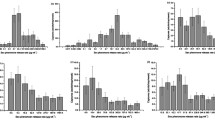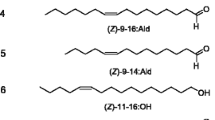Abstract
Since the discovery of the first sex pheromone and the adoption of pheromone in pest management, the global pheromone market size has grown to reach USD 2.4 billion per year in 2019. This has enabled the development of environmentally friendly approaches that significantly reduce the application of pesticides. Recently, there have been reports of the failure of various commercial codlemone: (E,E)-8,10-dodecadien-1-ol formulations used for monitoring the apple pest codling moth, Cydia pomonella (L.). This work was initiated to investigate factors behind the lack of efficacy of codlemone lure in the Northern Hemisphere (Germany) and Southern Hemisphere (New Zealand). We hypothesised that the observed failure could be due to two main factors: (a) a shift in the response of male codling moth to codlemone and (b) degradation of codlemone under field conditions that renders the lure less attractive. Field trial tests of various doses and blends containing minor pheromone compounds suggested no change in response of male codling moth. The addition of an antioxidant and a UV stabiliser to codlemone resulted in a significant increase in the number of males caught in Germany, but not in New Zealand. Mean maximum temperatures during the growing season since 2004 indicate a 3 °C increase to 35 °C in Germany, but just a 1.5 °C rise to 30 °C in New Zealand. Chemical analysis of the lures used in the field trials in Germany and New Zealand indicated more degradation products and reduced half-life of the lures in Germany compared with those in New Zealand. Heating codlemone lures to 32 °C significantly reduced the number of males caught in traps and increased the isomeric and chemical impurities of codlemone compared with unheated lures. Our data provide the first evidence that climate change affects pheromone molecule stability, thus reducing its biological efficacy. Our finding suggests that climate change could be a general problem for chemical communication and, therefore, could affect the integrity of natural ecosystems.






Similar content being viewed by others
Availability of data and material
Climatic datasets for both Germany and New Zealand are available from JG (upon request) and https://hortplus.metwatch.nz/ (paid subscription), respectively. Other data used in this study are also available from the corresponding author upon request.
Code availability (software application or custom code)
Not applicable.
Change history
15 December 2021
A Correction to this paper has been published: https://doi.org/10.1007/s00114-021-01770-w
References
Arn H, Schwarz C, Limao H, Mani E (1974) Sex attractant inhibitors of the codling moth Laspeyresia pomonella L. Experientia 30:1142–1144
Arn H, Guerin PM, Buser HR, Rauscher S, Mani E (1985) Sex pheromone blend of the codling moth, Cydia pomonella: evidence for a behavioral role of dodecan-l-ol. Experientia 41:1482–1484
Barnes MM (1991) Codling moth occurrence, host race formation, and damage. In: Van Der Geest LPS, Evenhuis HH (eds) Tortricid pests: their biology, natural enemies and control. Elsevier Science Publishing Co., Inc., New York, pp 313–327
Bartell RJ, Bellas TE, Whittle CP (1988) Evidence for biological activity of two further alcohols in the sex pheromone of female Cydia pomonella (L.) (Lepidoptera: Tortricidae). Aust J Entomol 27:11–12
Boullis A, Detrain C, Francis F, Verheggen FJ (2016) Will climate change affect insect pheromonal communication? Curr Opin Insect Sci 17:87–91
Boullis A, Fassotte B, Sarles L, Lognay G, Heuskin S, Vanderplanck M, Bartram S, Haubruge E, Francis F, Verheggen FJ (2017) Elevated carbon dioxide concentration reduces alarm signaling in aphids. J Chem Ecol 43:164–171
Boullis A, Blanchard S, Francis F, Verheggen F (2018) Elevated CO2 concentrations impact the semiochemistry of aphid honeydew without having a cascade effect on an aphid predator. Insects 9:47. https://doi.org/10.3390/insects9020047
Butenandt A, Beckmann R, Stamm D, Hecker E (1959) Über den Sexuallockstoff des Seidenspinners Bombyx mor. Reindarstellung Und Konstitution. Z Naturforsch B 14:283–284
Carson R (1962) Silent spring. Houghton Mifflin, Boston
Choi KS, Ahn SJ, Kim SB, Ahn JJ, Jung BN, Go SW, Kim DS (2018) Elevated CO2 may alter pheromonal communication in Helicoverpa armigera (Lepidoptera: Noctuidae). Physiol Entomol 43:169–179
Culver DJ, Barnes MM (1977) Contribution to the use of the synthetic pheromone in monitoring codling moth populations. J Econ Entomol 70:489–492
El-Sayed AM (2004) Behavioural effect of (E)-8,(Z)-10-dodecadien-1-ol and (E)-8,(E)-10-dodecadienyl acetate on the upwind orientation of male codling moth, Cydia pomonella to pheromone source. Behaviour 141:313–325
El-Sayed AM (2020) The Pherobase: database of pheromones and semiochemicals. http://www.pherobase.com. Accessed 16 Feb 2020
El-Sayed A, Unelius RC, Liblikas I, Löfqvist J, Bengtsson M, Witzgall P (1998) Effect of codlemone isomers on codling moth (Lepidoptera: Tortricidae) male attraction. Environ Entomol 27:1250–1254
El-Sayed A, Bengtsson M, Rauscher S, Lofqvist J, Witzgall P (1999) Multicomponent sex pheromone in codling moth (Lepidoptera: Tortricidae). Environ Entomol 28:775–779
El-Sayed A, Liblikas I, Unelius R (2000) Flight and molecular modeling study on the response of codling moth, Cydia pomonella (Lepidoptera: Tortricidae) to (E,E)-8,10-dodecadien-1-ol and its geometrical isomers. Z Naturforsch C 55:1011–1017
El-Sayed AM, Gibb AR, Suckling DM, Bunn B, Fielder S, Comeskey D, Manning LA, Foster SP, Morris BD, Ando T, Mori K (2005) Identification of sex pheromone components of the painted apple moth: a tussock moth with a thermally labile pheromone component. J Chem Ecol 31:633–657
El-Sayed AM, Suckling DM, Wearing CH, Byers JA (2006) Potential of mass trapping for long-term pest management and eradication of invasive species. J Econ Entomol 99:1550–1564
El-Sayed AM, Suckling DM, Byers JA, Jang EB, Wearing CH (2009) Potential of ‘lure and kill’ in long-term pest management and eradication of invasive species. J Econ Entomol 102:815–835
Fabre J-H (1879) Souvenirs entomologiques. 6 série. Etudes sur l'instinct et les moeurs des Insectes. Paris, France Marie Léonard
Götz B (1940) Sexualduftstoffe als Lockmittel in der Schädlingsbekämpfung. Umschau Wiss Technik 44:794–796
Götz B (1941) Der Sexualduftstoff als Bekämpfungsmittel gegen die Traubenwickler im Freiland. Wein Rebe 23:75–89
Grant GG, Slessor KN, Liu W, Abou-Zaid MA (2003) (Z, Z)-6,9-Heneicosadien-11-one, labile sex pheromone of the whitemarked tussock moth, Orgyia leucostigma. J Chem Ecol 29:589–601
Groot AT, Zizzari ZV (2019) Does climate warming influence sexual chemical signaling? Anim Biol 69:83–93
Gross J, Gündermann G (2016) Principles of IPM in cultivated crops and implementation of innovative strategies for sustainable plant protection. In: Horowitz RA, Ishaaya I (eds) Advances in insect control and resistance management. Springer Science + Business Media B.V, Dordrecht, pp 9–26 ISBN: 978-3-319-31798-4
Gu G, Adler RF, Huffman GJ (2016) Long-term changes/trends in surface temperature and precipitation during the satellite era (1979–2012). Clim Dyn 46:1091–1105
Ideses R, Shani A (1988) Chemical protection of pheromones containing an internal conjugated diene system from isomerization and oxidation. J Chem Ecol 14:1657–1669
Ideses R, Shani A, Klug JT (1982) Cyclic peroxide: an isolable intermediate in singlet oxidation of pheromones to the furan system. Chem Ind (Lond) 12:409–410
Kehat M, Anshelevich L, Dunkelblum E, Greenberg FP, S, (1994) Sex pheromone traps for monitoring the codling moth: effect of dispenser type, field aging of dispenser, pheromone dose and type of trap on male captures. Entomol Exp Appl 70:55–62
Lintner JA (1882) A new principle in protection from insect attack. Western New York Horticultural Society Proceedings 27:52–66
McDonough LM, Brown DF, Aller WC (1989) Insect sex pheromones. Effect of temperature on evaporation rates of acetates from rubber septa. J Chem Ecol 15:779–790
McDonough LM, Davis HG, Chapman PS, Smithhisler CL (1995) Codling moth, Cydia pomonella, (Lepidoptera: Tortricidae): is its sex pheromone multicomponent? J Chem Ecol 21:1065–1071
Millar JG (1995) Degradation and stabilization of E8, E10-dodecadienol, the major component of the sex pheromone of the codling moth (Lepidoptera Tortricidae). J Econ Entomol 88:1425–1432
Nunohiro A, Kumano N (2020) Effects of high CO2 on mating success, mating duration, and sperm transfer in the West Indian sweet potato weevil, Euscepes postfasciatus. Entomol Exp Appl 168:387–397
QYResearch Co. Limited (2019) Global IPM pheromones industry market research report. 2019. https://www.marketresearchstore.com/report/global-ipm-pheromones-industry-market-report-2019-industry-642230. Accessed 16 May 2020
SAS Institute Inc (1998) Statview. SAS Institute Inc., Cary
Scott PW (1995) Techniques and practice of chromatography. Marcel Dekker, New York
Sentis A, Ramon-Portugal F, Brodeur J, Hemptinne JL (2015) The smell of change: warming affects species interactions mediated by chemical information. Glob Change Biol 21:3586–3594
Schmidt S, Neulichedl P, Österreicher J, Pernter P, Preti M, Angeli S (2019) Failure of commercial sex-pheromone monitoring lures in the assessment of codling moth presence: an emerging problem in South Tyrol, pp. 146–147. In: PheroFIP 19: Joint Meeting of the IOBC/WPRS Working Groups “Pheromones and other semiochemicals in integrated production” & “Integrated Protection of Fruit Crops”, 20–25 January 2019, Lisbon, Portugal
Shani A, Klug JT (1980) Sex pheromone of Egyptian cotton leafworm (Spodoptera littoralis): its chemical transformations under field conditions. J Chem Ecol 6:875–881
Shani A, Ideses R, Klug JT, Skorka J, Eliyahu R (1982) Isomerization and oxidation of the conjugated double bonds system in pheromones. Colloques l’INRA 7:107–113
Shorey HH, Gaston LK, Saario CA (1967) Sex pheromones of noctuid moths. XIV. Feasibility of behavioral control by disrupting pheromone communication in cabbage loopers. J Econ Entomol 60:1541–1545
Stylianou N, Guibourg C (2019) Hundreds of temperature records broken over summer. https://www.bbc.com/news/science-environment-49753680. Accessed 30 Jul 2020
Thomson DR, Gut LJ, Jenkins JW (1999) Pheromones for insect control. In: Hall FR, Menn JJ (eds) Methods in biotechnology. Vol 5. Biopesticides: use and delivery. Humana Press Inc., Totowa, pp 385–412
Vickers RA, Rothschild GHL (1991) Use of sex pheromone for control of codling moth. In: Van der Geest LPS, Evenhuis HH (eds) Tortricid Pests. Elsevier, Amsterdam, pp 339–354
Witzgall P, Bengtsson M, Rauscher S, Liblikas I, Bäckman A-C, Coracini M, Anderson P, Löfqvist J (2001) Identification of further sex pheromone synergists in the codling moth, Cydia pomonella. Entomol Exp App 101:131–141
Acknowledgements
This work was funded by the New Zealand Ministry for Research Science and Innovation and Plant & Food Research’s Capability Fund. The heaters for rubber septa were designed and built by Taylor Welsh. Linnaeus University, Sweden, is thanked for financial support to CRU. MR and NG were supported by funds from the Federal Ministry of Food and Agriculture (BMEL) based on a decision of the Parliament of the Federal Republic of Germany via the Federal Office for Agriculture and Food (BLE) under the innovation support programme number 281B204316.
Funding
This work was funded by the New Zealand Ministry for Research Science and Innovation and Plant & Food Research’s Capability Fund. Linnaeus University, Sweden, is thanked for financial support to CRU. MR and NG were supported by funds from the Federal Ministry of Food and Agriculture (BMEL) based on a decision of the Parliament of the Federal Republic of Germany via the Federal Office for Agriculture.
Author information
Authors and Affiliations
Contributions
Ashraf El-Sayed, Rikard Unelius, and Jürgen Gross contributed to the study conception and design. Material preparation, data collection, and analysis were performed by Ashraf El-Sayed, Suresh Ganji, Natalie Giesen, Margit Rid, Jürgen Gross, Rikard Unelius, Peter Lo, and Anna Kokeny. The first draft of the manuscript was written by Ashraf El-Sayed and all authors commented on previous versions of the manuscript. All authors read and approved the final manuscript.
Corresponding author
Ethics declarations
Ethics approval
Not applicable.
Consent to participate
Not applicable.
Consent for publication
Not applicable.
Conflict of interest
The authors declare no competing interests.
Additional information
Communicated by: William Benjamin Walker
Publisher's note
Springer Nature remains neutral with regard to jurisdictional claims in published maps and institutional affiliations.
The original online version of this article was revised due to (1.) The first sentence in the Abstract sections that reads: “Since of the first sex pheromone and the adoption of pheromone in pest management, the global pheromone market size has grown to reach USD 2.4 billion per year in 2019.” should have been “Since the discovery of the first sex pheromone and the adoption of pheromone in pest management, the global pheromone market size has grown to reach USD 2.4 billion per year in 2019.” (2.) Figures 5 and 6 x-axes were changed “Temprature” to “Temperature”.
Supplementary Information
Below is the link to the electronic supplementary material.
Rights and permissions
About this article
Cite this article
El-Sayed, A.M., Ganji, S., Gross, J. et al. Climate change risk to pheromone application in pest management. Sci Nat 108, 47 (2021). https://doi.org/10.1007/s00114-021-01757-7
Received:
Revised:
Accepted:
Published:
DOI: https://doi.org/10.1007/s00114-021-01757-7




